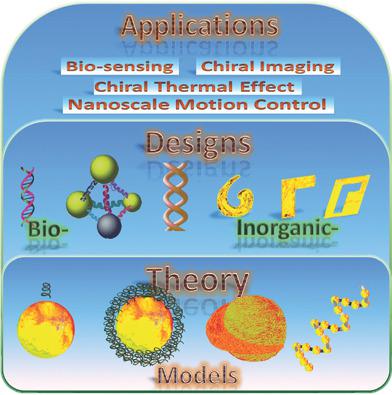当前位置:
X-MOL 学术
›
Adv. Mater.
›
论文详情
Our official English website, www.x-mol.net, welcomes your feedback! (Note: you will need to create a separate account there.)
Plasmonic Chirality and Circular Dichroism in Bioassembled and Nonbiological Systems: Theoretical Background and Recent Progress
Advanced Materials ( IF 29.4 ) Pub Date : 2018-09-09 , DOI: 10.1002/adma.201801790 Xiang‐Tian Kong 1, 2 , Lucas V. Besteiro 1, 3 , Zhiming Wang 1 , Alexander O. Govorov 2
Advanced Materials ( IF 29.4 ) Pub Date : 2018-09-09 , DOI: 10.1002/adma.201801790 Xiang‐Tian Kong 1, 2 , Lucas V. Besteiro 1, 3 , Zhiming Wang 1 , Alexander O. Govorov 2
Affiliation

|
Nature is chiral, thus chirality is a key concept required to understand a multitude of systems in physics, chemistry, and biology. The field of optics offers valuable tools to probe the chirality of nanosystems, including the measurement of circular dichroism, the differential interaction strength between matter and circularly polarized light with opposite helicity. Simultaneously, the use of plasmonic systems with giant light‐interaction cross‐sections opens new paths to investigate and manipulate systems on the nanoscale. Consequently, the interest in chiral plasmonic and hybrid systems has continually grown in recent years, due to their potential applications in biosensing, polarization‐encoded optical communication, polarization‐selective chemical reactions, and materials with polarization‐dependent light–matter interaction. Experimentally, chiral properties of nanostructures can be either created artificially using modern fabrication techniques involving inorganic materials, or borrowed from nature using bioassembly or biomolecular templating. Herein, the recent progress in the field of plasmonic chirality is summarized, with a focus on both the theoretical background and the experimental advances in the study of chirality in various systems, including molecular‐plasmonic assemblies, chiral plasmonic nanostructures, chiral assemblies of interacting plasmonic nanoparticles, and chiral metal metasurfaces and metamaterials. The growth prospects of this field are also discussed.
中文翻译:

生物组装和非生物系统中的等离子手性和圆二色性:理论背景和最新进展。
大自然是手性的,因此手性是理解物理学,化学和生物学中众多系统所需的关键概念。光学领域提供了有价值的工具来探测纳米系统的手征性,包括测量圆二色性,物质与具有相反螺旋度的圆偏振光之间的微弱相互作用强度。同时,具有巨大的光相互作用横截面的等离激元系统的使用开辟了研究和操纵纳米级系统的新途径。因此,由于手性等离激元和杂化系统在生物传感,偏振编码的光通信,偏振选择性化学反应以及具有偏振相关的光-物质相互作用的材料中的潜在应用,近年来对手性等离激元和混合系统的兴趣不断增长。实验上,纳米结构的手性可以使用涉及无机材料的现代制造技术人工创建,也可以使用生物组装或生物分子模板从自然界借鉴而来。在此,概述了等离子手性领域的最新进展,重点介绍了各种系统中的手性研究的理论背景和实验进展,包括分子-等离子体组装体,手性等离子体纳米结构,相互作用等离子体的手性组装体纳米粒子,手性金属超表面和超材料。还讨论了该领域的增长前景。在此,概述了等离子手性领域的最新进展,重点介绍了各种系统中的手性研究的理论背景和实验进展,包括分子-等离子体组装体,手性等离子体纳米结构,相互作用等离子体的手性组装体纳米粒子,手性金属超表面和超材料。还讨论了该领域的增长前景。在此,概述了等离子手性领域的最新进展,重点介绍了各种系统中的手性研究的理论背景和实验进展,包括分子-等离子体组装体,手性等离子体纳米结构,相互作用等离子体的手性组装体纳米粒子,手性金属超表面和超材料。还讨论了该领域的增长前景。
更新日期:2018-09-09
中文翻译:

生物组装和非生物系统中的等离子手性和圆二色性:理论背景和最新进展。
大自然是手性的,因此手性是理解物理学,化学和生物学中众多系统所需的关键概念。光学领域提供了有价值的工具来探测纳米系统的手征性,包括测量圆二色性,物质与具有相反螺旋度的圆偏振光之间的微弱相互作用强度。同时,具有巨大的光相互作用横截面的等离激元系统的使用开辟了研究和操纵纳米级系统的新途径。因此,由于手性等离激元和杂化系统在生物传感,偏振编码的光通信,偏振选择性化学反应以及具有偏振相关的光-物质相互作用的材料中的潜在应用,近年来对手性等离激元和混合系统的兴趣不断增长。实验上,纳米结构的手性可以使用涉及无机材料的现代制造技术人工创建,也可以使用生物组装或生物分子模板从自然界借鉴而来。在此,概述了等离子手性领域的最新进展,重点介绍了各种系统中的手性研究的理论背景和实验进展,包括分子-等离子体组装体,手性等离子体纳米结构,相互作用等离子体的手性组装体纳米粒子,手性金属超表面和超材料。还讨论了该领域的增长前景。在此,概述了等离子手性领域的最新进展,重点介绍了各种系统中的手性研究的理论背景和实验进展,包括分子-等离子体组装体,手性等离子体纳米结构,相互作用等离子体的手性组装体纳米粒子,手性金属超表面和超材料。还讨论了该领域的增长前景。在此,概述了等离子手性领域的最新进展,重点介绍了各种系统中的手性研究的理论背景和实验进展,包括分子-等离子体组装体,手性等离子体纳米结构,相互作用等离子体的手性组装体纳米粒子,手性金属超表面和超材料。还讨论了该领域的增长前景。


























 京公网安备 11010802027423号
京公网安备 11010802027423号